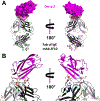Precision engineering for localization, validation, and modification of allergenic epitopes
- PMID: 38181840
- PMCID: PMC10939758
- DOI: 10.1016/j.jaci.2023.12.017
Precision engineering for localization, validation, and modification of allergenic epitopes
Abstract
The allergen-IgE interaction is essential for the genesis of allergic responses, yet investigation of the molecular basis of these interactions is in its infancy. Precision engineering has unveiled the molecular features of allergen-antibody interactions at the atomic level. High-resolution technologies, including x-ray crystallography, nuclear magnetic resonance spectroscopy, and cryo-electron microscopy, determine allergen-antibody structures. X-ray crystallography of an allergen-antibody complex localizes in detail amino acid residues and interactions that define the epitope-paratope interface. Multiple structures involving murine IgG mAbs have recently been resolved. The number of amino acids forming the epitope broadly correlates with the epitope area. The production of human IgE mAbs from B cells of allergic subjects is an exciting recent development that has for the first time enabled an actual IgE epitope to be defined. The biologic activity of defined IgE epitopes can be validated in vivo in animal models or by measuring mediator release from engineered basophilic cell lines. Finally, gene-editing approaches using the Clustered Regularly Interspaced Short Palindromic Repeats technology to either remove allergen genes or make targeted epitope engineering at the source are on the horizon. This review presents an overview of the identification and validation of allergenic epitopes by precision engineering.
Keywords: Allergens; CRISPR; IgE monoclonal antibody; allergen engineering; allergenic epitopes; nuclear magnetic resonance; x-ray crystallography.
Copyright © 2024 American Academy of Allergy, Asthma & Immunology. All rights reserved.
Conflict of interest statement
Figures




Similar articles
-
Structural Aspects of the Allergen-Antibody Interaction.Front Immunol. 2020 Sep 2;11:2067. doi: 10.3389/fimmu.2020.02067. eCollection 2020. Front Immunol. 2020. PMID: 32983155 Free PMC article. Review.
-
Multiple independent IgE epitopes on the highly allergenic grass pollen allergen Phl p 5.Clin Exp Allergy. 2014 Nov;44(11):1409-19. doi: 10.1111/cea.12423. Clin Exp Allergy. 2014. PMID: 25262820 Free PMC article.
-
Molecular basis of IgE-recognition of Lol p 5, a major allergen of rye-grass pollen.Mol Immunol. 1998 Apr;35(5):293-305. doi: 10.1016/s0161-5890(98)00050-9. Mol Immunol. 1998. PMID: 9747889
-
Allergenic and antigenic determinants of latex allergen Hev b 1: peptide mapping of epitopes recognized by human, murine and rabbit antibodies.Clin Exp Allergy. 1996 Apr;26(4):406-15. Clin Exp Allergy. 1996. PMID: 8732237
-
Human Monoclonal IgE Antibodies-a Major Milestone in Allergy.Curr Allergy Asthma Rep. 2023 Jan;23(1):53-65. doi: 10.1007/s11882-022-01055-w. Epub 2022 Dec 2. Curr Allergy Asthma Rep. 2023. PMID: 36459330 Free PMC article. Review.
Cited by
-
Pre-clinical allergenicity assessment of IgE epitope-targeted Der p 2 mutants demonstrate potential as hypoallergenic AIT candidates.Front Immunol. 2025 Jun 27;16:1623920. doi: 10.3389/fimmu.2025.1623920. eCollection 2025. Front Immunol. 2025. PMID: 40655157 Free PMC article.
-
Structural analysis of human IgE monoclonal antibody epitopes on dust mite allergen Der p 2.J Allergy Clin Immunol. 2024 Aug;154(2):447-457. doi: 10.1016/j.jaci.2024.04.017. Epub 2024 Apr 30. J Allergy Clin Immunol. 2024. PMID: 38697404 Free PMC article.
-
Research gaps and future needs for allergen prediction in food safety.Front Allergy. 2024 Feb 19;5:1297547. doi: 10.3389/falgy.2024.1297547. eCollection 2024. Front Allergy. 2024. PMID: 38440401 Free PMC article. Review.
-
Human IgE monoclonal antibodies define two unusual epitopes trapping dog allergen Can f 1 in different conformations.Protein Sci. 2025 Sep;34(9):e70269. doi: 10.1002/pro.70269. Protein Sci. 2025. PMID: 40828364 Free PMC article.
-
The Potential of Human Monoclonal IgE Antibodies to Establish Biological Potency and Stability of Allergen Extracts.Curr Allergy Asthma Rep. 2024 Sep;24(9):471-475. doi: 10.1007/s11882-024-01168-4. Epub 2024 Jul 24. Curr Allergy Asthma Rep. 2024. PMID: 39046600 Free PMC article. Review.
References
-
- Radauer C, Bublin M, Wagner S, Mari A, Breiteneder H. Allergens are distributed into few protein families and possess a restricted number of biochemical functions. J Allergy Clin Immunol 2008; 121:847–52. - PubMed
-
- Dramburg S, Hilger C, Santos AF, de Las Vecillas L, Aalberse RC, Acevedo N, et al. EAACI Molecular Allergology User’s Guide 2.0. Pediatr Allergy Immunol 2023; 34 Suppl 28:e13854. - PubMed
-
- Takai T, Yokota T, Yasue M, Nishiyama C, Yuuki T, Mori A, et al. Engineering of the major house dust mite allergen Der f 2 for allergen-specific immunotherapy. Nat. Biotechnol 1997; 15:754–8. - PubMed
Publication types
MeSH terms
Substances
Grants and funding
LinkOut - more resources
Full Text Sources

